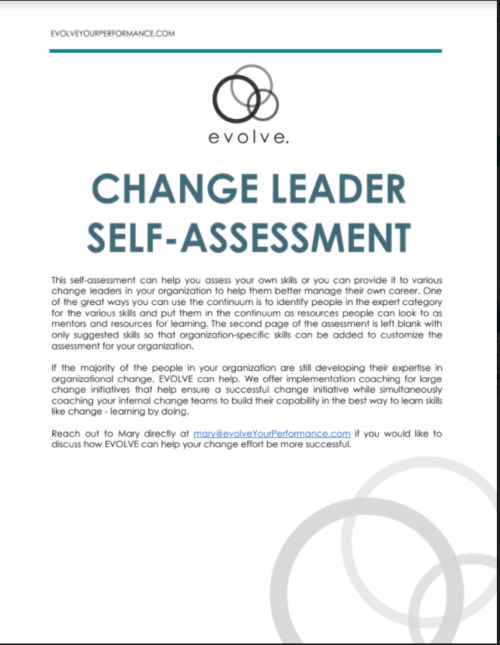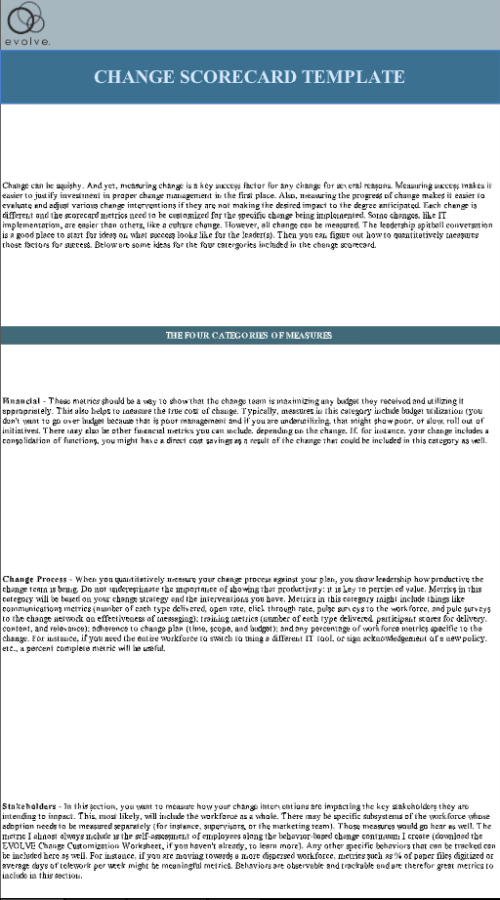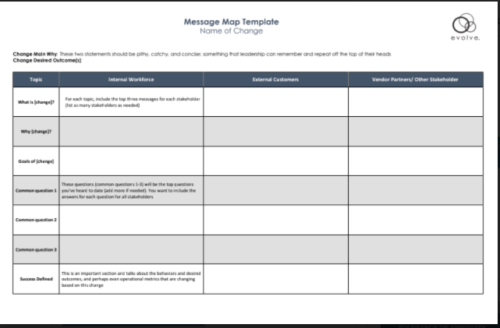-
 This self-assessment can help you assess your own skills or you can provide it to various change leaders in your organization to help them better manage their own career. One of the great ways you can use the continuum is to identify people in the expert category for the various skills and put them in the continuum as resources people can look to as mentors and resources for learning. The second page of the assessment is left blank with only suggested skills so that organization-specific skills can be added to customize the assessment for your organization.
This self-assessment can help you assess your own skills or you can provide it to various change leaders in your organization to help them better manage their own career. One of the great ways you can use the continuum is to identify people in the expert category for the various skills and put them in the continuum as resources people can look to as mentors and resources for learning. The second page of the assessment is left blank with only suggested skills so that organization-specific skills can be added to customize the assessment for your organization. -
 Research shows that an active and engaged executive sponsor is consistently a key driver of project success. Yet, the Project Management Institute found in 2018 that 38% of projects do not have active executive sponsorship. Below are things to consider when looking for a new executive sponsor as well as some factors to rate your existing executive sponsor against.
Research shows that an active and engaged executive sponsor is consistently a key driver of project success. Yet, the Project Management Institute found in 2018 that 38% of projects do not have active executive sponsorship. Below are things to consider when looking for a new executive sponsor as well as some factors to rate your existing executive sponsor against. -
 This diagnostic is based on EVOLVE's proprietary Organizational Hierarchy of Needs for peak organizational performance. Here at EVOLVE, we take a collaborative, people-first approach to alignment and execution to help organizations reach that peak performance, even in hard times. The first step is taking an honest look at five key elements to see where the organization is set up for future success and where there might be opportunities for improvement. Click the next button at the bottom of the page to start the diagnostic.
This diagnostic is based on EVOLVE's proprietary Organizational Hierarchy of Needs for peak organizational performance. Here at EVOLVE, we take a collaborative, people-first approach to alignment and execution to help organizations reach that peak performance, even in hard times. The first step is taking an honest look at five key elements to see where the organization is set up for future success and where there might be opportunities for improvement. Click the next button at the bottom of the page to start the diagnostic. -
 The following worksheet (that has sample data included) is intended to support the beginning phases of developing a change initiative. While this is just a few tabs, it is not intended to be accomplished in one sitting or by one person. Customizing a change and developing the final behavior-based change continuum should include the change team and even key stakeholders, if applicable. Some of these tabs in this workbook might be the singular topic in a whiteboarding workshop. Look for the various notes and pro tips throughout the workshop to help you figure out the best way to work through this effort. If you would like some help managing this customization process, feel free to reach out to Mary directly on mary@evolveYourPerformance.com to schedule some time to talk about how we can help you customize the change for optimal results. As you go through this workbook, use the buttons to navigate through the spreadsheet and make sure to only type into spaces identified so that you don't accidentally delete some of the formulas intended to help reduce your effort.
The following worksheet (that has sample data included) is intended to support the beginning phases of developing a change initiative. While this is just a few tabs, it is not intended to be accomplished in one sitting or by one person. Customizing a change and developing the final behavior-based change continuum should include the change team and even key stakeholders, if applicable. Some of these tabs in this workbook might be the singular topic in a whiteboarding workshop. Look for the various notes and pro tips throughout the workshop to help you figure out the best way to work through this effort. If you would like some help managing this customization process, feel free to reach out to Mary directly on mary@evolveYourPerformance.com to schedule some time to talk about how we can help you customize the change for optimal results. As you go through this workbook, use the buttons to navigate through the spreadsheet and make sure to only type into spaces identified so that you don't accidentally delete some of the formulas intended to help reduce your effort. -
 Creating a change charter is a great way to make sure everyone is on the same page before the change gets started. This should not be something that takes forever to write or get approved, it should just be an internal document that makes roles, responsibilities, change goals, and a few other things clear.
Creating a change charter is a great way to make sure everyone is on the same page before the change gets started. This should not be something that takes forever to write or get approved, it should just be an internal document that makes roles, responsibilities, change goals, and a few other things clear. -
 This scale was developed by Budner (1963) to measure an individual’s tolerance to ambiguity in life in general. For the purpose of this scale, tolerance for ambiguity is defined as: the degree to which an individual is comfortable with uncertainty, unpredictability, conflicting directions, and multiple demands.
This scale was developed by Budner (1963) to measure an individual’s tolerance to ambiguity in life in general. For the purpose of this scale, tolerance for ambiguity is defined as: the degree to which an individual is comfortable with uncertainty, unpredictability, conflicting directions, and multiple demands. -

Getting a clear message on what the head of an organization really wants to see as a result of a change can sometimes be much harder than it sounds. A lot of times, the leader “knows it when s/he sees it” but cannot really describe it in a concrete way to help the change leaders help ensure they truly get what they want. Having an informal “spitball” conversation with leadership is a great way get all of the thoughts out of the leader’s head and onto paper where plans can be made.
-
 As discussed, change is really about getting the workforce as a whole to change their behavior in one or more areas. When looking at levers to pull and metrics to adjust, you need to start with the behaviors you are trying to change. In workshop 2, we went over identifying the current and ideal behaviors associated with the specific change. Pull those behaviors up now. Or, if you didn’t do that, take some time now to think of the key behaviors that need to change for the organizational change to be successful.
As discussed, change is really about getting the workforce as a whole to change their behavior in one or more areas. When looking at levers to pull and metrics to adjust, you need to start with the behaviors you are trying to change. In workshop 2, we went over identifying the current and ideal behaviors associated with the specific change. Pull those behaviors up now. Or, if you didn’t do that, take some time now to think of the key behaviors that need to change for the organizational change to be successful. -
 Change can be squishy. And yet, measuring change is a key success factor for any change for several reasons. Measuring success makes it easier to justify investment in proper change management in the first place. Also, measuring the progress of change makes it easier to evaluate and adjust various change interventions if they are not making the desired impact to the degree anticipated. Each change is different and the scorecard metrics need to be customized for the specific change being implemented. Some changes, like IT implementation, are easier than others, like a culture change. However, all change can be measured. The leadership spitball conversation is a good place to start for ideas on what success looks like for the leader(s). Then you can figure out how to quantitatively measures those factors for success. Below are some ideas for the four catergories included in the change scorecard.
Change can be squishy. And yet, measuring change is a key success factor for any change for several reasons. Measuring success makes it easier to justify investment in proper change management in the first place. Also, measuring the progress of change makes it easier to evaluate and adjust various change interventions if they are not making the desired impact to the degree anticipated. Each change is different and the scorecard metrics need to be customized for the specific change being implemented. Some changes, like IT implementation, are easier than others, like a culture change. However, all change can be measured. The leadership spitball conversation is a good place to start for ideas on what success looks like for the leader(s). Then you can figure out how to quantitatively measures those factors for success. Below are some ideas for the four catergories included in the change scorecard. -
 Building good business requirements and a scope of work can sometimes be the most intimidating thing about the process of bringing on external support. But, if you have used the matrix and figured out the big buckets of your change framework so that the needs are clear, its really just a matter of putting your needs down on paper and asking people to show you how they can help.
Building good business requirements and a scope of work can sometimes be the most intimidating thing about the process of bringing on external support. But, if you have used the matrix and figured out the big buckets of your change framework so that the needs are clear, its really just a matter of putting your needs down on paper and asking people to show you how they can help.



